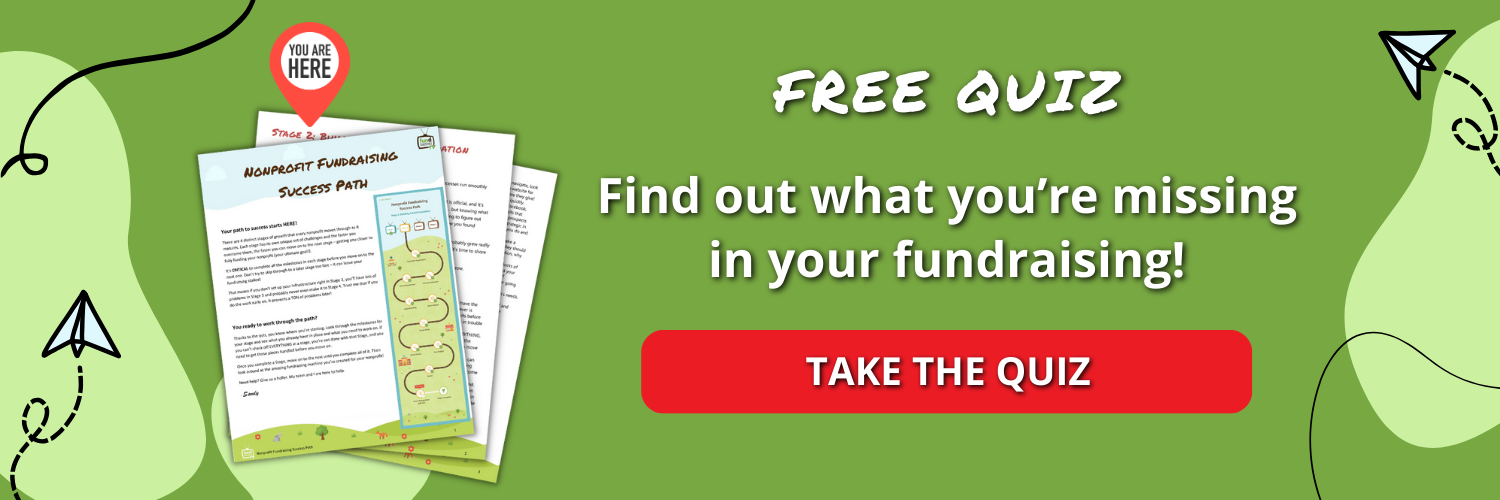 Sometimes we get so busy trying to raise money that we lose sight of something important: why people give.
Sometimes we get so busy trying to raise money that we lose sight of something important: why people give.
What makes someone pull out their credit card and click the ‘donate now’ button? Or mail in a check?
What makes someone give to one organization versus another one?
And more importantly, what makes someone give to YOUR nonprofit?
Understanding the psychology behind giving can help you understand the donor’s motivation, which will help you plan your next campaign, your next fundraising event, or your next face-to-face ask.
In short, when you know the reasons people support your cause, you have an edge in asking for – and getting – donations.
So, why do people give? And how do you use that information to raise more money?
Why People Make Donations
There are lots of reasons why people give.
Some give because they want to help others.
Some give because it’s their family or religious tradition.
Some want to make their community a better place.
And something extremely interesting? In a study referenced in Psychology Today, 85% of respondents said the reason they gave was simply because someone asked them.
That’s good news!
Here’s the truth: When you ASK, you’re more likely to receive than if you don’t ask – even if you don’t do a great job of making the ask.
If you nail the ask, addressing the reasons why people give, your chances of receiving a donation increase dramatically.

In other words, meeting your donors’ needs for giving will help open their heart and wallet to supporting your work.
Ok, so what makes people actually decide to give?
If you directly asked every donor why they give, they might not have just one answer.
Donors often respond to internal triggers that aren’t clear even to them.
For instance, they may give to the homeless shelter because they feel bad for people who don’t have homes…
or because it feels good to help someone in need…
or because their favorite uncle was homeless for a while…
or because of all those reasons!
It’s usually a complex mix of emotions that leads donors to give, although one emotion may trump the others.
There’s always a driving emotion that causes people to give. Donors may give out of empathy, sympathy, fear, guilt, or even anger.
Maybe your donors have walked a mile in the same shoes as your program participants. A woman who has escaped an abusive husband may give to your women’s shelter out of empathy. People who give to your legal defense fund for immigrants may feel angry at how immigrants are treated.
Developing an understanding of why people give can help you figure out which psychological triggers will lead to donations for your cause.
Knowing that, you can design your marketing and fundraising materials to appeal to the right emotions.
Psychologists have studied the dynamics of giving for years and identified some key internal motivators for giving. Here are the top eight, along with suggestions for using these.
8 Psychological Reasons Why People Give
1. Social Dynamics. Some people give because a particular cause or organization matters to someone they care about.
People who know someone with a specific disease might be much more willing to give to an organization that fights that disease. Maybe you have a friend who works at the food bank, and she’s so passionate that you end up volunteering or donating too. Maybe some guy’s girlfriend loves dogs, so he gives to the animal shelter where she volunteers to impress her. If a corporation sponsors a certain nonprofit, employees may be eager to support it as well – either because they love the cause or because it makes them look good at work.
Harness the power of social dynamics by:
 Making sure your donors, Board members, volunteers, and supporters have opportunities to invite people in their social networks to events and fundraisers or to follow your organization online. Encourage them to tell others about what you do and why.
Making sure your donors, Board members, volunteers, and supporters have opportunities to invite people in their social networks to events and fundraisers or to follow your organization online. Encourage them to tell others about what you do and why.- Having information readily available for them to post online or use in conversation. That means making the info visually pleasing and easily shareable.
- Developing relationships with corporate sponsors that go beyond once-a-year events, giving their employees a way to get more involved.
- Letting people know when someone donates! If someone donates through your Facebook link, thank the person publicly if possible. Recognition can be important to social givers.
2. Altruism. Many people who donate to charity believe it’s important to help people in need. They feel that people should give to others because it’s the just the right thing to do.
While psychologists debate whether pure altruism is real, altruistic people enjoy giving and receive pleasure from the action. Many people live this value, and it’s the main reason they give.
Harness the power of altruism by:
- Talking to and targeting faith and values-based organizations. This is a ready audience for altruistic appeals.
- Letting your donors know exactly why their help is needed, who will benefit, and how their life or situation will be made better. Altruistic donors usually love the story!
3. Trust. One of the reasons that people don’t give is that they believe their gift won’t really help or that the money won’t be used wisely.
We’ve all read news stories about national charities that mismanage funds. Those stories hurt every nonprofit because it erodes the public’s trust in our sector.
That means a lot of potential donors are now suspicious of every nonprofit and may approach giving with cynicism. They may worry that nonprofits aren’t effective or efficient with donated funds.
Successful organizations overcome this cynicism by proactively working to build trust.
They make it clear that donations are helping beneficiaries, by openly sharing their accomplishments, especially the important outcomes for each year.
They’re also fully transparent with their financial information, sharing their annual financial statements on their website for everyone to see.
Harness the power of trust by:
 Making it clear exactly where donations go and what impact they make.
Making it clear exactly where donations go and what impact they make.- Making financial statements public and easy to find.
- Maintaining a professional appearance throughout your organization, in any buildings, facilities, and online.
4. Impact. People are easily overwhelmed by large numbers. While the logical portions of our brains may be able to take in large numbers, our emotions have a harder time.
If we think for very long about the huge numbers of people in the world who are hungry or need medical attention, we may start to zone out or feel small and helpless. We see this a lot after natural disasters when hundreds of thousands of people need aid.
But if you can help donors see that their individual donation will make a real difference to one actual person (by telling their story), it can help your donor understand the situation and they’ll be inspired to give.
Harness the power of impact by:
- Telling stories that focus on ONE person or family. If you run a training program for seeing-eye dogs, focus on one dog and his human. Tell people how the beneficiary’s life is improved and all the things that person can now do. If you have photos or videos of Mr. Fuddles and his human, that’s even better! Instead of being overwhelmed by a mountain of statistics, your donor’s gift becomes part of a moving story.
- Calculating your Core Number. The Core Number takes into account all of your direct and indirect expenses to show what it costs you to deliver one unit of service. When you ask for a gift, don’t tell your donors you’re $6,000 away from your Spring campaign goal. Tell them that their gift of $15 will provide a week’s worth of lunches for kids in your Summer day camp for underserved children.
5. Goal Proximity. This simply means how close or far you are from your goal. This is particularly important when you’re publicly fundraising for an important project.
One of the reasons why people give towards the end of a campaign is that it feels like their contribution matters more – it’s moving you closer to the finish line.
Psychologists say that excitement of helping push a fundraiser over the line makes a donation feel more important. It’s much harder to get donations when you begin a fundraiser. That’s why it’s smart to start a large or capital campaign by getting all the “behind-the-scenes” donations and pledges first so when you announce the campaign publicly, you’re well on your way to the goal.
Harness the power of goal proximity by:
 Sharing updates on your campaign. Let people know how much more you need to raise and how the total campaign will make a difference in the lives of those you serve.
Sharing updates on your campaign. Let people know how much more you need to raise and how the total campaign will make a difference in the lives of those you serve.- Having a soft and a hard launch for your campaign. When you have a major gifts or capital campaign, split the campaign into a soft launch and a hard launch. Don’t start out by stating you have raised 0% of your goal. Before publicizing where you are in your fundraising, reach out to your biggest and best donors first to get their commitment. This is your soft launch, happening behind the scenes. When you announce the campaign to the public for the hard launch, you’ll already have demonstrated progress towards the goal.
6. Overcoming Difficulty. This one falls into the “strange but true category” of reasons why people give. Psychologists sometimes call this the martyrdom effect. It takes place when people expect to have to endure pain or difficulty to achieve a goal.
Think about the ice bucket challenge or the number of people who sign up for charity marathons. People actually want a challenge.
It’s the difference between giving one teenager a brand new car and having another teenager help pay for a car with a part-time job. Which teen is more likely to be more invested in taking care of the car?
People care about things they have to work for.
Harness the power of overcoming difficulty by:
- Holding challenging fundraising events that require some effort, like walk-a-thons, contests, or races.
- Having plenty of volunteer opportunities. Studies have shown that donors who volunteer donate more than those who don’t volunteer. It might seem counter intuitive, but doing fun or challenging work for a nonprofit makes donors feel like they have some skin in the game. Instead of feeling that they’ve done their part by sending in $50 once a year, they’ll want to do more. If you’ll expend your sweat for an organization, you’ll donate more to it.
7. Egoism. Another reason why people give is to receive a personal benefit. Psychologists call this egoism, but it’s not necessarily a bad thing.
People want to feel good about themselves or look good to someone else. Some donors value the financial benefit of giving – like saving money on taxes or impressing customers and clients.
This may not be the main motivator for most donors, but probably even the most altruistic people experience psychological benefits from giving.
Even if giving is a life-long moral or religious tradition, helping someone else leads to warm fuzzy feelings, which means the donor gets to feel good about giving.
Harness the power of egoism by:
 Making sure to thank your donors and help them feel good about their giving experience. Get creative. Send videos and make phone calls. Make sure your donors know you care about them and that they’re doing something positive through your nonprofit!
Making sure to thank your donors and help them feel good about their giving experience. Get creative. Send videos and make phone calls. Make sure your donors know you care about them and that they’re doing something positive through your nonprofit!- Updating donors on what their donations have done. Let them know exactly how many people your food bank helped. Let them know how many foster kids received scholarships and then focus on a success story.
- Naming names. Always call your donors by name. Never send out a generic Ask or thank you! Donors want to feel seen.
- Offering naming opportunities. For those donors who want their name on something, offer them options for naming a building, a tree, or something else meaningful.
8. FOMO. Fear of Missing Out is defined as a fear that others might be having a rewarding experience from which you are absent.
There have been a lot of studies about this phenomenon recently in relation to social media. Although this may seem entirely negative (the media tends to focus on depression caused by spending too long looking at other’s achievements and accomplishments) that’s not always the case.
FOMO drives people to seek connection, and if they find it, that’s a good thing. All human beings need to belong, and they seek out groups with similar values and sensibilities.
Donors are looking for personal connections and rewarding experiences just like anyone else. FOMO can be a driving factor in why people give or attend your event.
Nonprofits aren’t just organizations that distribute money. People who share a cause are a community who have rewarding experiences together.
Harness the power of FOMO by:
- Posting stories and links (or newsletter articles) that let potential donors see how they can get involved. Donors do not have to be physically present to feel they are part of your community.
- Making sure someone on your staff is designated to answer online messages and queries and to manage online discussions. You want donors to feel included and heard, and you don’t want to allow negative interactions to go unchecked. You can alleviate the fear of missing out by providing a safe warm community for donors to join.
- Having fun events – both online and offline. Contests, even silly ones, like a contest to name a rescued animal for a t-shirt, can trigger FOMO, but unlike following an Instagram influencer, these events can give your audience a chance to pitch in (instead of sitting on the sidelines feeling left out).
The Bottom Line
Understanding why people give helps you better understand your donors.
And that’s a good thing.
It helps you deliver information and experiences that’ll delight your donors, which keeps them around and keeps them giving.
Happy donors are loyal donors – making fundraising easier.
Additional Information
3 Psychological Triggers That Can Help You Win Donations https://www.classy.org/blog/3-psychological-triggers-to-win-donations/







[…] Giving is an emotional act Understanding why people give is essential to having a successful fundraising plan. Donors feel sympathy, empathy, guilt, or some other emotion when they donate. Knowing which emotion triggers donations to your organization can help you be more effective in fundraising. By Sandy Rees […]
I totally agree with your insight that if the donors can see that they can bring real change to the lives of the people, they are most likely to empathize and donate. My friend and I recently opened a comic book store, and it’s actually doing pretty well. Right now, we’re thinking of ways of how we can give back to the community, because one of our core values in our small business is to provide aid to those who are in need. We’ll make sure to find a child based nonprofit organization so that they can accommodate us to help certain families and children.
That’s a great idea! I’m sure you’ll be able to find a nonprofit that will partner with you.
A great article! Thank you very much for this information. I am training Missionary associates on how to raise their funds. This article was a great help.
So glad to hear this was helpful Marlene!
It was nice that you said that the donors of a non-profit organization must be provided with something that can make them feel good about giving help. This actually reminds me of my goal to find a youth mentoring organization that I can financially help and support on my 35th birthday. For sure, I will find a way to encourage others to make a donation as well to help the youth who were in trouble but wanted to recover.
How inspiring!
It sure was interesting when you said that people feel that their contributions matter more when they donate towards the end of a campaign. This reminds me of organizations that support youth welfare and development. My husband and I will actually celebrate our son’s first birthday next month, so we will consider making donations to give back.
Bea, I know this is a delayed response (and I do apologize for that), but thank you for sharing your thoughts with us. I hope your son’s first year has been a great one for you and your family. Please let us know how else we can be of support. – Coach Jessie
I found your tip helpful when you said to do a soft and hard launch on our campaign by not starting by stating we have raised 0% to meet the goal to harness the power of goal proximity. My company sells clothes for kids, and we were thinking of donating to charity soon. I’ll keep what you said in mind just in case while I look for an anti-hate youth engagement program we can donate to soon.
Thank you so much for thinking this through & being so thoughtful on your approach. Your community is lucky to have such a charitable individual and locally-owned company. Please let us know if we can answer anything further or be of assistance. Thank you for all that you do. We wish you great success! – Coach Jessie
I’m glad you mentioned that some people give to charities because they want to help other people. This is exactly why my husband and I want to donate to a charity this spring. We have been saving up some money to give to a charity of our choice, so we’ll have to find one whose message we agree with.
I love this, Charlotte. Thank you so much for all that you are doing. I can’t wait to hear about the charity that you choose and know your dollars will go right to work. I really appreciate you sharing this here.
– Coach Jessie
Thank you for sharing.
I will apply the skills.